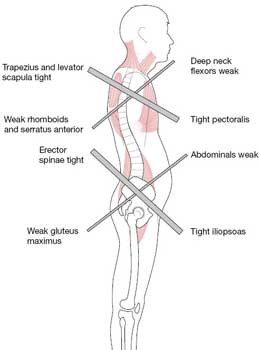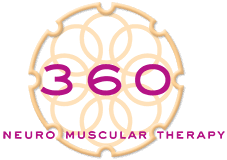Muscle Imbalance
Upper and Lower Crossed Syndrome
Presenting symptoms
 A 23-year old yoga instructor came in with pain in the right shoulder blade that was worse in seated positions (such as driving or sitting on couch). He also said his hamstrings remained incredibly tight, regardless of how much he stretched them.
A 23-year old yoga instructor came in with pain in the right shoulder blade that was worse in seated positions (such as driving or sitting on couch). He also said his hamstrings remained incredibly tight, regardless of how much he stretched them.
Evaluation, clinical reasoning & treatment strategizing
We observed that the painful right shoulder appeared lower. Previous treatment to “the spot” behind his right shoulder blade had only provided temporary relief. The pelvis showed a shift (translation) to the right, a right-sided anterior pelvic rotation, and a sway back. Muscle testing revealed weak hip flexors. While the patient thought that his hamstrings were tight, range of motion tested normal.
We explained that the hamstring muscle group might actually be taut, rather than tight. Taut muscles are stretched long but still radiate a feeling of tightness. Our posture evaluation connected the hamstrings and shoulder pain through the pelvic obliquities. By treating the muscles affected by imbalances in his torso and pelvis, we reasoned the shoulder pain may reduce spontaneously. Much of this theory is based on the work of Vladimir Janda, MD, of the Czech Republic, who coined the phrases ‘upper and lower crossed syndromes,’ used to describe common patterns of ‘tightness’ and ‘weakness’ found in the upper and lower parts of the body.
Treatment
In order to reduce pain, we first treated the muscles that had to work hard to counter-balance the postural shift to the right side. We treated the right high adductor (inner thigh), the left abductors and the left low back. Next, we treated and lengthened the right hip flexor group and lumbar erectors to reduce anterior pelvic tilt. All the shoulder muscles were treated bilaterally.
Outcomes and follow-up
This case shows the importance of distinguishing the words “tight” (short) and “taut” (stretched long). To the patient both tight and taut can feel the same. Distortions and imbalances within the pelvis can lead to pain in other areas of the body. In this case, once balance was restored in the pelvis, the patient’s shoulder height equalized. Pain was reduced and his balance also improved. The right hip flexor needed to be strengthened to maintain the newly corrected position. The patient was also given self-care activities and instructed not to overstretch the hamstrings going forward.







